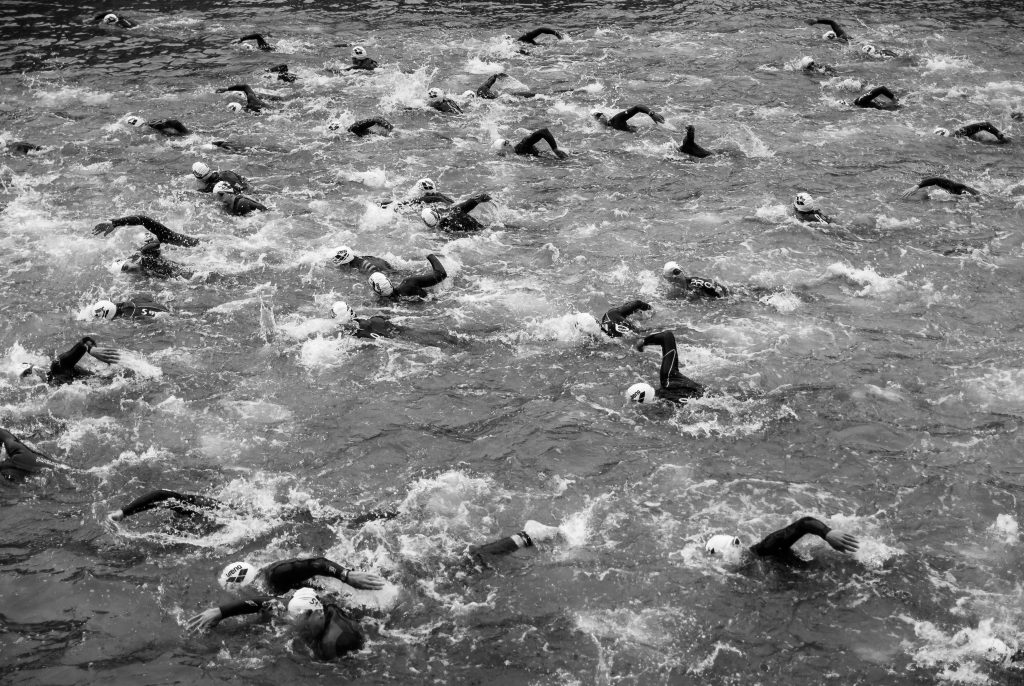
By Rob Shaul
I’ve been asked many times over the years to design triathlon-specific training plans and until now, I’ve always resisted. Why?
First – triathlon programming is out of MTI’s lane in programming primarily for mountain and tactical athletes.
Second – there is a plethora of triathlon training plans already available – whereas, especially when I started, there was little available for mountain/tactical-specific programming.
So why now? I’ve just had so many mountain and tactical athletes over the years want to complete a triathlon and have asked for a plan from me. Recently, these requests increased significantly.
For years I’ve owned multiple triathlon-plan training books and have also followed the latest movements in endurance programming. My approach here at MTI is if possible, not to re-invent the wheel, so I began my triathlon programming effort by reading the 5 books by well-known triathlon and endurance coaches I’ve got in my library.
After reading these books, now I can understand better how MTI customers wanted MTI triathlon plans. What exists out there now for triathlon training is so complicated, as a strength and conditioning coach, even I had problems following along!
- There were multiple narrowly-defined levels of effort, complicated by power and/or heart rate zone training, and overly sophisticated, hard-to-follow interval work/rest efforts. The triathlon programming I reviewed would simply be very difficult to follow.
- Next, all the existing triathlon-specific programming was time-based, not distance-based – which I found surprising. Triathlons aren’t time-based events.
In other words, for a Sprint-distance triathlon, you don’t swim as far as you can in 15 minutes, then bike as far as you can in 60 minutes, then run as far as you can in 30 minutes. Rather, the competitor must swim 750m, bike 20k, and run 5k as fast as possible. The race is distance-based.
Another issue I found with the triathlon-programming books and resources I reviewed was the first time the authors had the athletes complete an actual triathlon was the race. Never in the course of the train up did the athletes actually complete the event they were training for.
One of the things I work hard to include in MTI event programming is to include as best as possible, the actual event the athlete is training for.
This is why MTI PFT programming starts with the actual PFT and often includes 2-3 follow-on PFTs in the train up.
For some events – military selections for example – I can’t perfectly design programming which perfectly matches the event for several reasons. This is why our programming often includes weekend-mini-events which are designed to approximate long, multi-modal days that athletes will face at selection. This way, we do our best to ensure that the athlete who is completing the plan knows what this feels like both physically and mentally, so when it happens at selection, they’ve been there before.
However, the Sprint, Olympic, and Half-Ironman Triathlon distances are no secret. So I included them in our tri-specific plans.
Ultimately, as I designed MTI’s triathlon training plans, I ended up combining the work we’ve previously done in endurance event programming for ultra runs and long rucking events, with our work on tactical training courses and selection programming. The result is triathlon-specific programming much different from what is available from other sources.
Here are the key components of MTI’s Triathlon programming approach:
– Most of the programming is distance-based including assessments, threshold intervals, and specific-distance weekend triathlons.
– The programming does not include any moderate-paced efforts. Athletes either train as a threshold pace for distance (assessments, intervals, triathlons), or an easy pace for time (i.e. 75-minute bike at an easy pace).
– Repeated individual assessments on the three legs of the triathlon, and follow-on threshold intervals based on the assessment results. So MTI’s Sprint Distance Triathlon Training Plan begins with a 750m swim for time on Monday, followed by a 20k bike for time on Tuesday and a 5k run for time on Wednesday.
– A full triathlon is completed every Saturday. Again – I want the athlete to know what completing a triathlon feels like before the real thing. The leg distances for the triathlon progress with the plan. For example, the actual leg distances for a Half Ironman Triathlon are 1,950m Swim, 90k Bike, and 21k run. In our Half-Ironman Triathlon Plan, the first Saturday triathlon has a 750m Swim, 30k Bike, and 7k Run. As the athlete works through the program and increases fitness, the leg distances in the Saturday triathlon also increase until Week 7, when the athlete completed a full Half Ironman on Saturday.
– For the Olympic and Half Ironman Training Plans, the individual leg assessments also increase in distance. So, in the Half Ironman Plan, week 1 doesn’t begin with a 90k bike assessment. Instead Week 1’s bike assessment is 30k. On Week 4 the assessment increased to 60k, and on Week 7 it again increases to the event distance of 90k.
– Thursday’s in the plans are gym-based strength and work capacity, and Fridays are rest days.
– In terms of intensity, overall MTI’s triathlon programming is significantly more intense than the standard approach I researched.
Here is the Half Ironman Weekly Schedule:
- Mon: 750m, 1,500m or 1,950m Swim Assessment or Swim Intervals plus an easy Run
- Tue: 45K, 60K or 90K Bike Assessment or Bike Intervals
- Wed: 9K, 15K or 21K Run Assessment or Run Intervals plus an easy Swim
- Thu: Gym-Based Strength & Chassis Integrity or Rest
- Fri: Total Rest
- Sat: Triathlon
- Sun: Easy Bike plus Easy Run or Rest
Planning a triathlon or simply want to train for one? Here are the links to MTI’s plans:
- Sprint Distance Triathlon Training Plan
- Olympic Distance Triathlon Training Plan
- Half Ironman Triathlon Training Plan
Questions, Comments, Feedback? Email rob@mtntactical.com
YOU MIGHT ALSO LIKE EVENT NUTRITION: CANDY BARS OVER ENDURANCE SUPPLEMENTS
